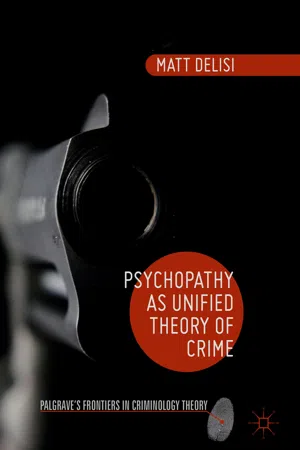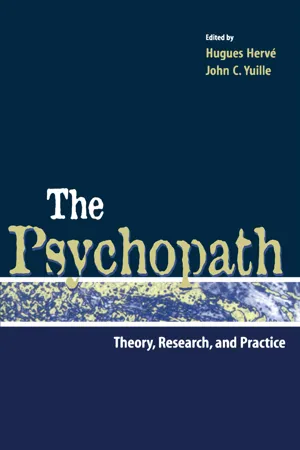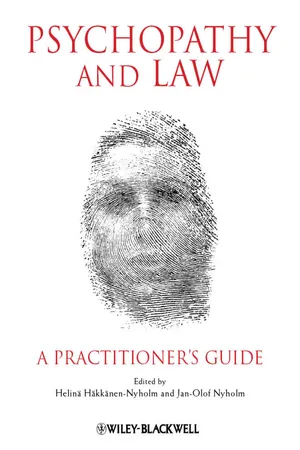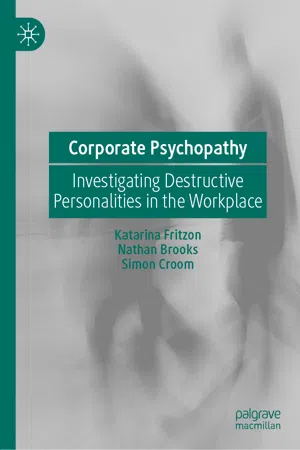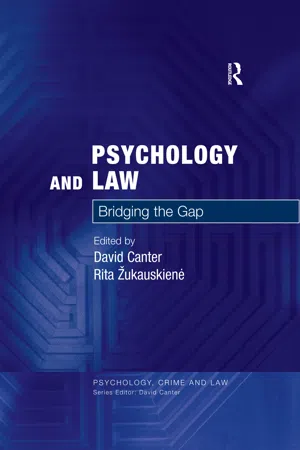Contemporary Research - Language of Psychopaths
Contemporary research on the language of psychopaths explores the linguistic patterns and characteristics of individuals with psychopathic traits. It investigates how psychopaths use language to manipulate and deceive others, as well as the differences in their speech compared to non-psychopathic individuals. This research aims to enhance our understanding of psychopathy and its potential applications in forensic psychology and criminal justice.
7 Key excerpts on "Contemporary Research - Language of Psychopaths"
- eBook - ePub
- Matt DeLisi(Author)
- 2016(Publication Date)
- Palgrave Macmillan(Publisher)
...(2003, p. 467) Even the ways that psychopathic homicide offenders describe their killings are antisocial. Hancock, Woodworth, and Porter (2013) performed an ingenious study that examined the linguistic patterns of speech and semantic content that psychopathic killers and non-psychopathic killers used to describe their murder events. They found that psychopathic killers used rational, cause-and-effect descriptors of their crime, were utilitarian in their explanation, and their language contained few references to social needs or relationships. They had difficulty describing the emotional content of the crime and their speech was more likely to contain disfluencies. They also used more past tense and less present tense as a way to distance themselves from the crime, and to distance themselves from their perceived responsibility for the crime. The current author once interviewed a defendant who was charged with several counts of sexually molesting his grandchildren. The defendant had a four-decades-long criminal history that included a prior homicide event. When asked about the disposition of that homicide case (meaning did it result in a conviction, and if so, how long was the sentence and how many years were served in prison), the defendant responded completely without affect, “A guy who I fought in the bar came up to my car window, and I stabbed him, and he died. I don’t remember how long the sentence was, it should be in my record.” As the defendant uttered this phrase, he motioned with his hands toward the pile of criminal history reports that were on the desk as if the information should be ascertained by going through the files. In addition to the Canadian and US data described above, Lindberg et al. (2009) analyzed data from all 15- to 19-year-old male offenders in Finland who had been subjected to a forensic psychiatric examination and who were convicted of homicide...
- eBook - ePub
The Psychopath
Theory, Research, and Practice
- Hugues Herve, John C. Yuille, Hugues Herve, John C. Yuille(Authors)
- 2017(Publication Date)
- Routledge(Publisher)
...As indicated earlier, Hervé (2000, 2002, chap. 17, this volume) has empirically shown that psychopaths differ in terms of their interpersonal and behavioral features. As alluded to earlier, we propose that certain subtypes are more likely to use deception, to use deception more successfully, and to be able to detect deception in others more accurately than other subtypes. Although it is an empirical question, we anticipate that prototypical psychopaths and manipulative psychopaths would be more adept at deception and the detection of deception than explosive psychopaths and pseudopsychopaths. CONCLUSION In this chapter we reviewed the relevant literature on psychopathy and deception. Clinical wisdom and anecdotal evidence suggest that psychopathic criminals lie a lot. The research in this area is flawed, but it is clear that deception is a major issue with psychopaths and that, more than individuals with any other personality disorder, these individuals will lie just for the pleasure of lying. How successful psychopaths are as liars appears to depend upon context: those well trained in credibility assessment (e.g., polygraphers) can detect lies in psychopaths at the same rate as they do in nonpsychopaths. However, psychopaths often seem to succeed in their lies when the recipient is naïve and/or ready to suspend his or her disbelief. Finally, although the amount of research is limited, theory suggests that psy-should not be good lie detectors. Hare et al. (1989) made the following statement more than 15 years ago: “… although we know with certainty that psychopaths lie, deceive, and manipulate others, their performance on various tests associated with lying and deception is typically normal. Perhaps the most plausible reasons for this situation are that the various inventories and procedures currently in use lack ecological validity and are simply not sensitive to assess deception by psychopaths” (p. 44)...
- eBook - ePub
Psychopathy and Law
A Practitioner's Guide
- Helinä Häkkänen-Nyholm, Jan-Olof Nyholm, Jan-Olof Nyholm(Authors)
- 2012(Publication Date)
- Wiley-Blackwell(Publisher)
...However, during the years she has repeatedly discovered that it is at her clinical practice that she really gains insight into the world of a psychopathic individual. The reverse process has actually happened to the second author, who has had a long career in social interaction with suspects of crime and criminals at all levels and covering the whole variety of criminality. This work has taught him a lot of the process of interacting with different kinds of personalities in high-stakes situations. However, during all these years, it was not until he started working together with the first author and when he learned of psychopathy “from an academic point of view” that he was able to link together some of his experiences in a way that gave a reason and meaning for the behaviors and reactions he had witnessed during interviews, various intelligence operations, and the interrelationship between criminal structures. The Structure of This Text The text attempts to introduce practitioners to the core areas of psychopathy. For a researcher it aims to provide up-to-date empirical information with a link to case studies of psychopathy. There are some areas which have not been touched on previously in the scientific literature on psychopathy: those that relate to the interpersonal behavior of a psychopathic individual in serious crime such as organized crime or war crime, and family environment. The text is divided into 13 independent chapters: In Chapter 2 Michael Vitacco, David Lishner, and Craig Neumann identify and discuss the basic psychometric properties of the PCL instruments with specific emphasis in applying them in the courtroom setting. They further examine appropriate and inappropriate uses of PCL instruments in adversarial proceedings, discuss possible ethical concerns in using PCL-R, and provide some important questions clinicians using PCL instruments should expect to encounter on direct or cross-examination...
- Annamaria Di Fabio, Donald H. Saklofske, Con Stough(Authors)
- 2020(Publication Date)
- Wiley(Publisher)
...In terms of prevalence, psychopaths appear to be more likely than non‐psychopathic criminals to rape. In addition, psychopaths are overrepresented in samples of sexual offenders and appear to constitute a coherent subgroup of rapists. Moreover, the impulsive‐antisocial deviance component of psychopathy has been found to predict subsequent sexually aggressive behavior in convicted offenders. The components of psychopathy have also been demonstrated to predict sexually coercive behavior against women in non‐criminal samples. Clinical and forensic interest in psychopathy also involves the implications for treatment amenability. Therapeutic pessimism about psychopathy has been so engrained among clinicians and researchers that it is rarely subjected to empirical evaluation. Of those that have been conducted, most have had serious methodological flaws, such as the lack of randomized controlled trials, difficulty with reliably measuring treatment outcomes, and the lack of treatment programs developed specifically for those with psychopathy. Furthermore, psychopathic traits tend to be associated with low treatment motivation and poorer treatment response. A recent review of the literature reported that treatment results for adult psychopaths range from low‐moderate to poor. However, a small body of quasi‐experimental evidence challenges the assumption that individuals with psychopathy do not respond to conventional treatment. For example, a meta‐analysis of 42 studies indicated that across treatment modalities, psychotherapy was moderately successful in reducing recidivism for psychopathic individuals (on average, a 62% success rate). Furthermore, a study of 871 civil psychiatric patients indicated that individuals with psychopathic tendencies who received intensive treatment during one 10‐week period appeared just as likely to benefit from treatment as nonpsychopathic patients, in terms of reduced violence potential...
- eBook - ePub
Philosophy, Psychiatry and Psychopathy
Personal Identity in Mental Disorder
- Christopher Heginbotham, Christopher Heginbotham(Authors)
- 2021(Publication Date)
- Routledge(Publisher)
...1 Philosophy, Psychiatry and Personal Identity Clinics, Concepts and Philosophy of Psychopathy CHRISTOPHER HEGINBOTHAM This book arose out of a conference organised by the Society for Applied Philosophy in 1997 to explore conceptual issues at the interface of philosophy, psychiatry, psycho-analysis, and law. Conference participants brought a wealth of experience and insights across the whole field of mental disorder, but the main elements of participants’ papers and the ensuing discussion focused on the problems of personal identity and disordered personality, with specific attention to psychopathic personality disorder. A number of the papers collected here deal with the construction of personal identity and identification, but the depth of analysis of personality disorder at the conference was somewhat unexpected, and suggested that the focus of this book should be on psychopathy. Psychopathic personality disorder (sometimes called psychopathy, or severe personality disorder, or sociopathy) is a clinical and social presentation which has challenged philosophers, psychiatrists, psychologists and lawyers for many years. There is no single definition of psychopathy nor a common understanding of the aetiology, taxonomy and genealogy of psychopathy. Working criteria have been established (Hare, 1980) and an expanding literature testifies to the burgeoning interest in psychopathic personality disorder. One reason why psychopathy has been under-researched is that for many years medicine (psychiatry) has considered persons with psychopathy to be untreatable and therefore to be outside the normal realm of psychiatric intervention...
- eBook - ePub
Corporate Psychopathy
Investigating Destructive Personalities in the Workplace
- Katarina Fritzon, Nathan Brooks, Simon Croom(Authors)
- 2019(Publication Date)
- Palgrave Macmillan(Publisher)
...Indeed, Hickey (2010) suggested that psychopaths might be more likely to operate as white-collar criminals than violent murderers. However, research has overwhelmingly focused on incarcerated populations, with prevalence rates for correctional inmates ranging from 15 to 25% (Hare, 1996), while the community prevalence (i.e. the general population) is estimated to be only approximately one in 100 (Hare, 1999b). More recently, literature has turned towards examining manifestations of psychopathy in high-functioning populations, such as the corporate and political sectors, and three key strands of research have emerged as crucial in understanding this “new” form of psychopathy. These are: (1) theoretical and conceptual explanations for high-functioning psychopathy; (2) the core defining personality, cognitive and affective components of high-functioning psychopathy, including differences between the high-functioning and low-functioning criminal psychopath ; and (3) the most appropriate ways of measuring or assessing psychopathy in noncriminal populations. Of practical concern, the need for appropriate assessment tools is illustrated by the vast differences reported in prevalence rates, ranging from 3% (Babiak, Neumann, & Hare, 2010) using the short form of the Psychopathy Checklist-Revised (PCL-SV; Hart, Cox, & Hare, 1995) to 12% (Croom, 2017) using the Psychopathic Personality Inventory-Revised (PPI-R; Lilienfeld & Widows, 2005). Psychopathy has always been recognised as a paradoxical condition, with individuals being devoid of outwardly obvious signs and symptoms of mental disorder, while possessing significant emotional and cognitive deficits (Cleckley, 1988, Lilienfeld et al., 2012, Lykken, 1995). Cleckley (1941, 1976) described psychopathic individuals as charming, fearless and bold, interpersonally dominant, with intact intellectual functioning and low anxiety, yet also reckless and dishonest...
- eBook - ePub
Psychology and Law
Bridging the Gap
- David Canter, Rita Žukauskiene(Authors)
- 2017(Publication Date)
- Routledge(Publisher)
...There is also broad agreement that criminal behaviour, while being associated with psychopathy, is not a core defining feature (Blackburn, 2005). Current work suggests that clinicians experienced with this group of patients have a more sophisticated view of the disorder, adding further domains including problems of self, attachment, and cognitive processing (e.g. Cooke et al., 2006c; and below). In summary, it is evident that the construct of psychopathy has been recognised across time and across cultures both in formal and informal descriptions; it, or cognate constructs, has had a central importance in forensic thinking for over two centuries; and over time, clinical descriptions have become more specific, with the importance of antisocial behaviour as a marker of the disorder remaining controversial. Current Concerns and Controversies regarding Psychopathic Personality Disorder The diagnosis of psychopathy has always been a contentious diagnosis. Toch (1998), for example, argued that the diagnosis is a form of counter-transference – a label given to patients that a therapist does not like. However, Mullen (1992), while acknowledging the pejorative connotations of the term, argued that there is a group of individuals for which this, or some other, descriptive term is required. Evidence for the validity of the construct has improved dramatically over the last decade with evidence from the genetic, developmental, neuropsychological, neurochemical, psychometric, clinical and forensic – amongst other – domains becoming available (e.g. Cooke et al., 1996; Patrick, 2006). A major step towards fuller understanding of this disorder over the last two decades has been the development of the Hare’s Psychopathy Checklist-Revised (PCL-R; Hare 2001, 2003). This currently remains the instrument of choice for measuring psychopathy (Stone, 1995)...
